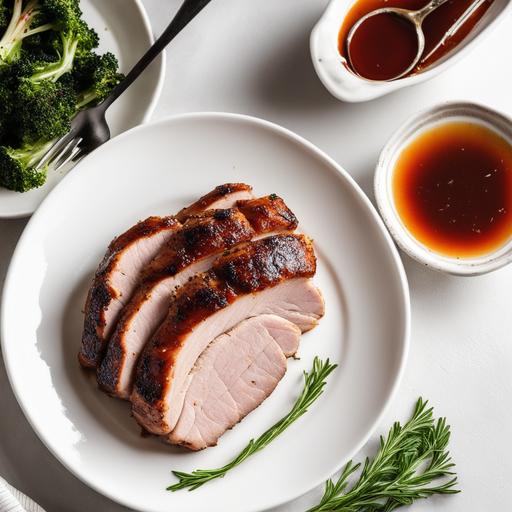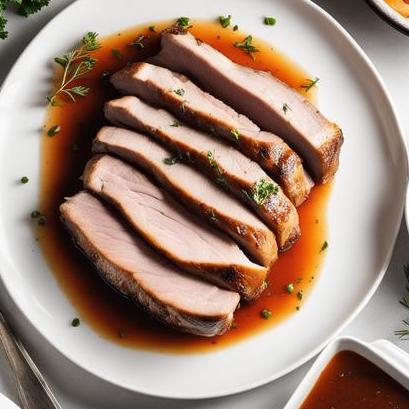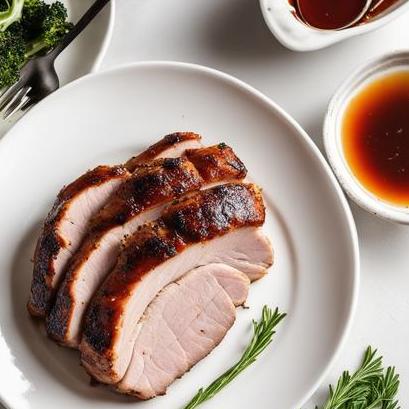
Pork Loin Roast Oven Recipe: A Flavorful And Tender Delight
Indulge in the delectable flavors and succulent textures of a perfectly cooked pork loin roast. In this comprehensive guide, we dive into the art of preparing, cooking, and serving this delightful dish. From the science behind pork loin, the culinary nuances, selection tips, cleaning and preparation techniques, to foolproof recipe variations, doneness checks, and potential pitfalls—this article has got you covered! Prepare for a culinary adventure that will leave your taste buds begging for more.
Understanding the Science: Pork Loin Roast Unveiled
Pork loin is a versatile and lean cut of meat that is renowned for its mild flavor and tender texture. It is obtained from the back of the pig, known as the loin, and is best suited for roasting due to its low-fat content. This ensures that the meat remains moist and tender during the cooking process.
When cooked to perfection, pork loin roast shines with a delicate pink interior and a caramelized crust on the outside. Achieving such a harmonious balance requires attention to various culinary elements, so let’s embark on our culinary journey step-by-step.
Selecting the Perfect Pork Loin
When selecting your pork loin roast, opt for a cut that is well-marbled and has a pinkish color. This marbling—a fine dispersion of fat throughout the muscle—ensures moistness and promotes flavor development during cooking. Aim for a roast with a thickness of at least 2 inches to ensure even cooking and a juicy result.
Ensure that the pork loin’s fat cap is intact, smooth, and evenly distributed. This layer of fat not only adds flavor but also helps baste the meat from within, maintaining moisture and tenderness throughout the roasting process. Ask your butcher for a boneless pork loin roast, as it is easier to handle and cook evenly.
Cleaning and Preparing the Pork Loin

Before delving into the cooking process, it’s essential to clean and prepare the pork loin roast. Start by rinsing it under cold water to remove any impurities. Pat it dry using paper towels, ensuring the moisture is soaked up, which provides a better sear during roasting.
Next, take a sharp knife and score the fat cap on top of the roast. Create shallow cuts in a crisscross pattern, approximately half an inch apart. This process not only enhances the roast’s appearance but also allows the seasonings to penetrate the meat, resulting in a more flavorful end product.
Tips for Flavorful Seasoning and Marination

To infuse the pork loin roast with mouthwatering flavors, consider marinating it beforehand. This step is optional, but can greatly enhance the overall taste and tenderness. Prepare a marinade of your choice, combining ingredients like olive oil, garlic, herbs such as rosemary and thyme, and a splash of acidic liquid like apple cider vinegar or lemon juice.
Create a small incision in the meat and rub the marinade all over. Allow the pork loin roast to marinate in the refrigerator for at least an hour, up to overnight, ensuring that it’s covered securely. This allows the flavors to penetrate the meat and tenderize it further. Remember to discard any leftover marinade to avoid cross-contamination.
If you prefer a dry rub, combine a variety of spices like smoked paprika, cumin, brown sugar, salt, and pepper. Massage this mixture into the scored fat and let it sit for 30 minutes before roasting. The dry rub adds a flavor-packed crust to the roast, enhancing its overall appeal.
Exploring Flavorful Variations

Now that you have a basic understanding of prepping the pork loin roast, let’s explore some delightful variations to the recipe. Don’t hesitate to get creative and tailor your roast to suit your personal preferences or incorporate cultural twists. Here are a few tantalizing options:
1. Citrus and Herb Infusion
Inject your pork loin roast with bright and zesty flavors. Combine lemon and orange zest, minced garlic, and fresh herbs like thyme and parsley. Marinate the roast and let the vibrant citrus notes work their magic.
2. Asian-inspired Glaze
Add an Oriental touch to your roast by preparing a glaze featuring soy sauce, ginger, honey, and a hint of garlic. Brush this glaze onto the roast during the final stages of cooking, allowing it to caramelized into a sticky, flavorful coating.
3. Smoky and Spicy Twist
For those who crave a kick of heat, a smoky and spicy variation is bound to satisfy. Prepare a chipotle and smoked paprika rub. Combine these ingredients with cayenne pepper, garlic, salt, and a touch of sugar. The result—a succulent roast with a fiery edge.
The Art of Achieving Perfect Doneness

Cooking pork loin roast to perfection requires precision and attention to detail. Overcooking can result in dry, tough meat, while undercooking poses potential health risks. Achieving the ideal doneness ensures a juicy, flavorful roast that will have your guests singing your praises.
Checking for Doneness
To determine if your pork loin roast is cooked to perfection, a meat thermometer is your best friend. Insert the thermometer probe into the thickest part of the meat, away from the bone. The internal temperature should reach a minimum of 145 degrees Fahrenheit (63 degrees Celsius).
Alternatively, check for doneness visually. Cut a small slit in the center of the roast. The meat should be slightly pink, moist, and tender. Avoid cutting too much, as this can cause excessive moisture loss during the resting process.
Resting for Optimal Juiciness
Resist the urge to dive right into carving your roast once it’s cooked. Resting the meat allows the juices to redistribute, resulting in a more succulent and evenly cooked roast. Tent the roast loosely with aluminum foil and let it rest for 10-15 minutes before carving.
Recipe: Pork Loin Roast Perfected
Now that you’ve gained insight into the various elements of preparing a mouthwatering pork loin roast, let’s dive into a classic recipe that encapsulates all the information discussed. This recipe promises to be your go-to guide for achieving a flavorful and tender masterpiece:
Ingredients:
-
1 boneless pork loin roast (approximately 4-5 pounds)
-
2 tablespoons olive oil
-
4 garlic cloves, minced
-
2 sprigs fresh rosemary
-
2 sprigs fresh thyme
-
Salt and pepper to taste
Instructions:
-
Preheat the oven to 325 degrees Fahrenheit (160 degrees Celsius).
-
In a small bowl, combine the minced garlic, olive oil, salt, and pepper.
-
Score the fat cap of the pork loin roast in a crisscross pattern.
-
Rub the garlic and oil mixture thoroughly over the roast.
-
Place the roast on a rack in a roasting pan. Arrange the rosemary and thyme sprigs on top.
-
Insert a meat thermometer into the thickest part of the roast, without touching the bone.
-
Roast the pork loin in the preheated oven for approximately 20 minutes per pound.
-
Once the internal temperature reads 145 degrees Fahrenheit (63 degrees Celsius), remove the roast from the oven and cover it loosely with foil. Allow it to rest for 10-15 minutes.
-
Finally, slice the roast into tender, succulent portions and serve alongside your favorite sides or sauces.
Avoiding Common Pitfalls
To avoid potential pitfalls and ensure the success of your pork loin roast, consider the following:
-
Avoid Overcooking: Keep a close eye on the internal temperature using a meat thermometer. Overcooking will result in dry and tough meat.
-
Safely Storing Leftovers: Store any leftover pork loin roast promptly in the refrigerator, ensuring it is properly covered or wrapped. Consume within 3-4 days to maintain freshness.
-
Cease the Undercooking: Always prioritize food safety. Undercooked pork can harbor harmful bacteria like trichinella. Be diligent about reaching the minimum internal temperature of 145 degrees Fahrenheit (63 degrees Celsius).
-
Slicing with Precision: Slice your roast against the grain for optimal tenderness. This technique breaks up the muscle fibers, resulting in a more enjoyable eating experience.
By meticulously following these guidelines, you’ll soon master the art of preparing a flawless pork loin roast.
A Culinary Triumph Awaits!
Congratulations! Armed with this comprehensive guide, you are now equipped to embark on a culinary expedition and experience the wonders of a perfectly cooked pork loin roast. From understanding the science behind the cut, selecting the ideal roast, cleaning, and preparation techniques to exploring delightful flavor variations, achieving perfect doneness, and avoiding common pitfalls—you are well-prepared to create an unforgettable dining experience.
Seize this opportunity to impress your loved ones with your newfound culinary prowess. Elevate an ordinary evening into an extraordinary one and savor every succulent bite of this mouthwatering delicacy. The possibilities are endless, so unleash your creativity and let the pork loin roast take center stage on your dining table!
Sources
FAQS On Pork Loin Roast Oven Recipe
How Long Should I Cook A Pork Loin Roast In The Oven?
The cooking time for a pork loin roast in the oven can vary depending on the size of the roast and the desired level of doneness. As a general guideline, you can cook a boneless pork loin roast at 350°F (175°C) for approximately 20 minutes per pound. However, for the most accurate results, it is recommended to use an instant-read meat thermometer inserted into the thickest part of the roast. The pork loin roast is done when the internal temperature reaches 145°F (63°C) for medium-rare or 160°F (71°C) for medium.
Do I Need To Marinate A Pork Loin Roast Before Cooking It?
Marinating a pork loin roast is not necessary, but it can enhance the flavor and tenderness of the meat. If you choose to marinate the pork loin roast, make sure to use an acidic marinade containing ingredients such as vinegar, citrus juice, or wine. The acidic marinade helps to break down the muscle fibers and impart flavor into the meat. For best results, marinate the pork loin roast in the refrigerator for at least 4 hours or overnight.
Should I Sear The Pork Loin Roast Before Putting It In The Oven?
Searing the pork loin roast before roasting it in the oven is an optional step, but it can add depth of flavor and create an appealing crust on the meat. To sear the pork loin roast, heat a little oil in a skillet over medium-high heat and brown the roast on all sides until golden brown. This process locks in the juices of the meat and creates a visually appealing caramelized surface. After searing, transfer the pork loin roast to a preheated oven to finish cooking.
How Can I Keep The Pork Loin Roast Moist In The Oven?
To keep a pork loin roast moist in the oven, there are a few tips you can follow. First, make sure not to overcook the roast, as this can result in dry meat. Utilize a meat thermometer to ensure the roast reaches the desired internal temperature but does not exceed it. Second, consider using a basting liquid or a butter herb mixture to periodically brush over the pork loin roast while it is cooking. This helps to add moisture and flavor to the meat. Additionally, covering the roast loosely with foil during cooking can also help retain moisture.
Can I Stuff The Pork Loin Roast For Added Flavor?
Yes, stuffing a pork loin roast can be a great way to add flavor and create an impressive presentation. You can choose from a variety of stuffing options, such as herb and breadcrumb stuffing, fruit and nut stuffing, or even vegetable stuffing. To stuff the pork loin roast, make a pocket in the center of the roast by cutting a slit horizontally and then vertically, being careful not to cut all the way through. Fill the pocket with your desired stuffing mixture, secure with toothpicks, and then proceed with roasting according to your recipe’s instructions. Remember to adjust the cooking time accordingly to ensure the stuffing is thoroughly cooked.



